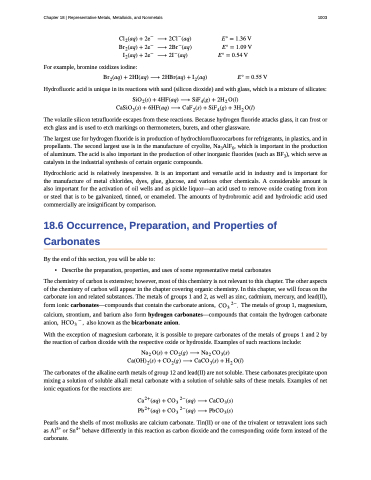Page 1013 - Chemistry--atom first
P. 1013
Chapter 18 | Representative Metals, Metalloids, and Nonmetals
1003
������� � ��� � �������� ������� � ��� � �������� ������ � ��� � �������
For example, bromine oxidizes iodine:
�� � ���� �
�� � ���� � �� � ���� �
�� � ���� � ������� � ������� � ������� � ��� ����
��������� � ������� � ������� � ������� � ��� ����
The volatile silicon tetrafluoride escapes from these reactions. Because hydrogen fluoride attacks glass, it can frost or
etch glass and is used to etch markings on thermometers, burets, and other glassware.
The largest use for hydrogen fluoride is in production of hydrochlorofluorocarbons for refrigerants, in plastics, and in propellants. The second largest use is in the manufacture of cryolite, Na3AlF6, which is important in the production of aluminum. The acid is also important in the production of other inorganic fluorides (such as BF3), which serve as catalysts in the industrial synthesis of certain organic compounds.
Hydrochloric acid is relatively inexpensive. It is an important and versatile acid in industry and is important for the manufacture of metal chlorides, dyes, glue, glucose, and various other chemicals. A considerable amount is also important for the activation of oil wells and as pickle liquor—an acid used to remove oxide coating from iron or steel that is to be galvanized, tinned, or enameled. The amounts of hydrobromic acid and hydroiodic acid used commercially are insignificant by comparison.
18.6 Occurrence, Preparation, and Properties of Carbonates
By the end of this section, you will be able to:
• Describe the preparation, properties, and uses of some representative metal carbonates
The chemistry of carbon is extensive; however, most of this chemistry is not relevant to this chapter. The other aspects of the chemistry of carbon will appear in the chapter covering organic chemistry. In this chapter, we will focus on the carbonate ion and related substances. The metals of groups 1 and 2, as well as zinc, cadmium, mercury, and lead(II), form ionic carbonates—compounds that contain the carbonate anions, ��� ��� The metals of group 1, magnesium,
calcium, strontium, and barium also form hydrogen carbonates—compounds that contain the hydrogen carbonate anion, ���� � � also known as the bicarbonate anion.
With the exception of magnesium carbonate, it is possible to prepare carbonates of the metals of groups 1 and 2 by the reaction of carbon dioxide with the respective oxide or hydroxide. Examples of such reactions include:
��� ���� � ������ � ��� ������ ���������� � ������ � �������� � �� ����
The carbonates of the alkaline earth metals of group 12 and lead(II) are not soluble. These carbonates precipitate upon mixing a solution of soluble alkali metal carbonate with a solution of soluble salts of these metals. Examples of net ionic equations for the reactions are:
�������� � ��� ������ � �������� �������� � ��� ������ � ��������
Pearls and the shells of most mollusks are calcium carbonate. Tin(II) or one of the trivalent or tetravalent ions such as Al3+ or Sn4+ behave differently in this reaction as carbon dioxide and the corresponding oxide form instead of the carbonate.
������� � ������� � �������� � ������
Hydrofluoric acid is unique in its reactions with sand (silicon dioxide) and with glass, which is a mixture of silicates:


